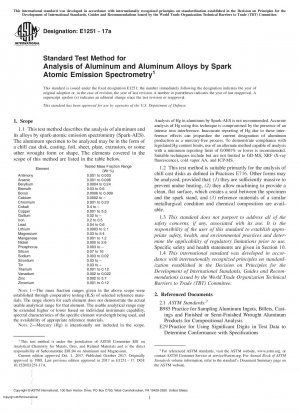ASTM E1251-17a
Test Method for Analysis of Aluminum and Aluminum Alloys by Atomic Emission Spectrometry
- Standard No.
- ASTM E1251-17a
- Release Date
- 2017
- Published By
- American Society for Testing and Materials (ASTM)
- Latest
- ASTM E1251-17a
- Scope
- 1.1 This test method describes the analysis of aluminum and its alloys by spark-atomic emission spectrometry (Spark-AES). The aluminum specimen to be analyzed may be in the form of a chill cast disk, casting, foil, sheet, plate, extrusion, or some other wrought form or shape. The elements covered in the scope of this method are listed in the table below. Element Tested Mass Fraction Range (Wt %) Antimony 0.001 to 0.003 Arsenic 0.001 to 0.006 Beryllium 0.0004 to 0.24 Bismuth 0.03 to 0.6 Boron 0.0006 to 0.009 Calcium 0.0002 to – Chromium 0.001 to 0.23 Cobalt 0.4 to – Copper 0.001 to 5.5 Gallium 0.02 to – Iron 0.2 to 0.5 Lead 0.04 to 0.6 Lithium 0.0003 to 2.1 Magnesium 0.03 to 5.4 Manganese 0.001 to 1.2 Nickel 0.005 to 2.6 Phosphorus 0.003 to – Silicon 0.07 to 16 Sodium 0.003 to 0.02 Strontium 0.03 to – Tin 0.03 to – Titanium 0.001 to 0.12 Vanadium 0.002 to 0.022 Zinc 0.002 to 5.7 Zirconium 0.001 to 0.12 NOTE 1—The mass fraction ranges given in the above scope were established through cooperative testing (ILS) of selected reference materials. The range shown for each element does not demonstrate the actual usable analytical range for that element. The usable analytical range may be extended higher or lower based on individual instrument capability, spectral characteristics of the specific element wavelength being used, and the availability of appropriate reference materials. NOTE 2—Mercury (Hg) is intentionally not included in the scope. Analysis of Hg in aluminum by Spark-AES is not recommended. Accurate analysis of Hg using this technique is compromised by the presence of an intense iron interference. Inaccurate reporting of Hg due to these interference effects can jeopardize the current designation of aluminum production as a mercury-free process. To demonstrate compliance with legislated Hg content limits, use of an alternate method capable of analysis with a minimum reporting limit of 0.0001% or lower is recommended. Suitable techniques include but are not limited to GD-MS, XRF (X-ray fluorescence), cold vapor AA, and ICP-MS. 1.2 This test method is suitable primarily for the analysis of chill cast disks as defined in Practices E716. Other forms may be analyzed, provided that: (1) they are sufficiently massive to prevent undue heating, (2) they allow machining to provide a clean, flat surface, which creates a seal between the specimen and the spark stand, and (3) reference materials of a similar metallurgical condition and chemical composition are available. 1.3 This standard does not purport to address all of the safety concerns, if any, associated with its use. It is the responsibility of the user of this standard to establish appropriate safety, health, and environmental practices and determine the applicability of regulatory limitations prior to use. Specific safety and health statements are given in Section 10. 1.4 This international standard was developed in accordance with internationally recognized principles on standardization established in the Decision on Principles for the Development of International Standards, Guides and Recommendations issued by the World Trade Organization Technical Barriers to Trade (TBT) Committee.
ASTM E1251-17a Referenced Document
- ASTM B985 Standard Practice for Sampling Aluminum Ingots, Billets, Castings and Finished or Semi-Finished Wrought Aluminum Products for Compositional Analysis
- ASTM E1329 Standard Practice for Verification and Use of Control Charts in Spectrochemical Analysis
- ASTM E135 Standard Terminology Relating to Analytical Chemistry for Metals, Ores, and Related Materials
- ASTM E1507 Standard Guide for Describing and Specifying the Spectrometer of an Optical Emission Direct-Reading Instrument
- ASTM E158 Standard Practice for Fundamental Calculations to Convert Intensities into Concentrations in Optical Emission Spectrochemical Analysis (Withdrawn 2004)
- ASTM E172 Practice for Describing and Specifying the Excitation Source in Emission Spectrochemical Analysis (Withdrawn 2001)
- ASTM E29 Standard Practice for Using Significant Digits in Test Data to Determine Conformance with Specifications
- ASTM E305 Standard Practice for Establishing and Controlling Spectrochemical Analytical Curves
- ASTM E406 Standard Practice for Using Controlled Atmospheres in Spectrochemical Analysis
- ASTM E691 Standard Practice for Conducting an Interlaboratory Study to Determine the Precision of a Test Method
- ASTM E716 Standard Practices for Sampling Aluminum and Aluminum Alloys for Spectrochemical Analysis
- ASTM E826 Standard Practice for Testing Homogeneity of Materials for Development of Reference Materials
ASTM E1251-17a history
- 2017 ASTM E1251-17a Test Method for Analysis of Aluminum and Aluminum Alloys by Atomic Emission Spectrometry
- 2017 ASTM E1251-17 Standard Test Method for Analysis of Aluminum and Aluminum Alloys by Spark Atomic Emission Spectrometry
- 2011 ASTM E1251-11 Standard Test Method for Analysis of Aluminum and Aluminum Alloys by Spark Atomic Emission Spectrometry
- 2007 ASTM E1251-07 Standard Test Method for Analysis of Aluminum and Aluminum Alloys by Atomic Emission Spectrometry
- 2004 ASTM E1251-04 Test Method for Analysis of Aluminum and Aluminum Alloys by Atomic Emission Spectrometry
- 1994 ASTM E1251-94(1999) Standard Test Method for Optical Emission Spectrometric Analysis of Aluminum and Aluminum Alloys by the Argon Atmosphere, Point-to-Plane, Unipolar Self-Initiating Capacitor Discharge
